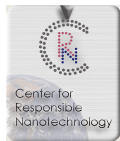














- Request More Info
- News and Events
- Latest C-R-Newsletter
- C-R-Newsletter Archives - 2003
- C-R-Newsletter Archives - 2004
- C-R-Newsletter Archives - 2005
- C-R-Newsletter Archives - 2006
- C-R-Newsletter Archives - 2007
- C-R-Newsletter Archives - 2008
- Press Releases
- Nanotechnology Press Kit
- Articles of Interest to CRN
- World Care & CRN Conference — September 2007
- Ideas and Publications
- Introduction to Nanotechnology
- Nanotechnology Basics: For Students and Other Learners
- Managing Magic
- Nanotechnology on an Upward Slope (PPT)
- The Next Industrial Revolution (PPT)
- Creating Policy for Advanced Nanotechnology (PPT)
- Unbounding the Future — Nano Simulation
- 5-Minute Nanosystems
- CRN Research: Results of Our Ongoing Research
- Timeline for Molecular Manufacturing
- Products of Molecular Manufacturing
- Benefits of Molecular Manufacturing
- Dangers of Molecular Manufacturing
- No Simple Solutions
- Administration Options
- Possible Technical Restrictions
- The Need for International Control
- The Need for Immediate Action
- A Solution that Balances Many Interests
- The Need for Early Development
- The Need for International Development
- Thirty Essential Nanotechnology Studies
- Is mechanically guided chemistry a viable basis for a manufacturing technology?
- To what extent is molecular manufacturing counterintuitive and underappreciated in a way that causes underestimation of its importance?
- What is the performance and potential of diamondoid machine-phase chemical manufacturing and products?
- What is the performance and potential of biological programmable manufacturing and products?
- What is the performance and potential of nucleic acid manufacturing and products?
- What other chemistries and options should be studied?
- What applicable sensing, manipulation, and fabrication tools exist?
- What will be required to develop diamondoid machine-phase chemical manufacturing and products?
- What will be required to develop biological programmable manufacturing and products?
- What will be required to develop nucleic acid manufacturing and products?
- How rapidly will the cost of development decrease?
- How could an effective development program be structured?
- What is the probable capability of the manufacturing system?
- How capable will the products be?
- What will the products cost?
- How rapidly could products be designed?
- Which of today's products will the system make more accessible or cheaper?
- What new products will the system make accessible?
- What impact will the system have on production and distribution?
- What effect will molecular manufacturing have on military and government capability and planning, considering the implications of arms races and unbalanced development?
- What effect will this have on macro- and microeconomics?
- How can proliferation and use of nanofactories and their products be limited?
- What effect will this have on policing?
- What beneficial or desirable effects could this have?
- What effect could this have on civil rights and liberties?
- What are the disaster/disruption scenarios?
- What effect could this have on geopolitics?
- What policies toward development of molecular manufacturing does all this suggest?
- What policies toward administration of molecular manufacturing does all this suggest?
- How can appropriate policy be made and implemented?
- Log of Updates
- Published Papers
- Accurately Describing a Technology That Does Not Yet Exist
- Applying the Precautionary Principle to Nanotechnology
- Bridges to Safety, and Bridges to Progress
- Commentary on Royal Society Nanotechnology Workshop
- Design of a Primitive Nanofactory
- Developing Molecular Manufacturing
- Molecular Manufacturing: Start Planning
- Molecular Manufacturing: What, Why and How
- Debate of Chemistry, Nanobots, and Policy
- Projected Environmental Impacts of Molecular Manufacturing
- Safe Exponential Manufacturing
- Safe Utilization of Advanced Nanotechnology
- Technical Commentary on Greenpeace Nanotechnology Report 2003
- Thirty Essential Nanotechnology Studies
- Three Systems of Action: A Proposed Application for Effective Administration of Molecular Nanotechnology
- Briefing Documents
- CRN Global Task Force Essays
- CRN Global Task Force Scenario Series
- Science and Technology Essays - 2004
- Science and Technology Essays - 2005
- Science and Technology Essays - 2006
- Science and Technology Essays - 2007
- Science and Technology Essays - 2008
- Sander Olson Interviews
- Andrew Adamatzky
- Michael Anissimov
- Damien Broderick
- Jeff Chinn
- Hugo DeGaris
- André DeHon
- Jack Dunietz
- Ali Eftekhari
- Glenn Fishbine
- Robert A. Freitas Jr.
- Britt Gillette
- J. Storrs Hall
- Jeffrey Harrow
- Eric Henderson
- Francis Heylighen
- Ray Kurzweil
- Gary Mezo
- Jagdish Narayan
- Christine Peterson
- Chris Phoenix
- Deepak Srivistava
- James Talton
- Adrian Tymes
- David Vivancos
- Asking the Right Questions
- U.S. Nanotechnology Policy — Missing the Point
- Commentary on Nano
- CRN Glossary
- About CRN
- Areas of Interest
- CRN Global Task Force on Implications and Policy
- CRN Student Research Program
- Nanotechnology Basics: For Students and Other Learners
- Studies of Molecular Manufacturing
- CRN's Positions
- CRN Global Task Force Members
- Public Speaking
- Inside CRN
- Support CRN
- Links
- Frequently Asked Questions
- What Can I Do?
Inform your communities


Home | About Us | Donate | FAQ | Nano Tomorrows | CRN Blog | Site Map | Contact CRN
Last updated on